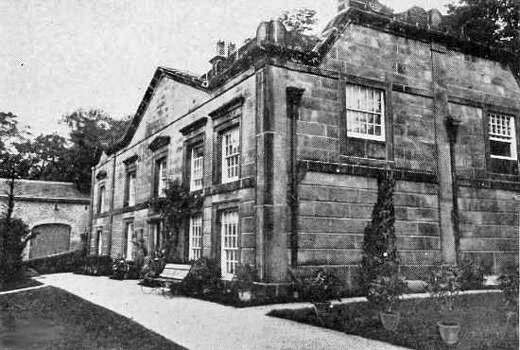Reveal, Revell, Revill Study
Revell Grange, Sheffield


At Nethergate Hall, a domestic chapel of Revell family, it was the custom when Mass was to be said for a white sheet to be hung on a certain bush as a signal to Catholics in the countryside. The hall was succeeded by Revell Grange in 1742 and closed in 1828. In 1855 it re opened and closed in 1929. The original Records of this extract of Roman Catholic Records are held by Sheffield Archives
Captain Sutton
It is believed the last Revell family member to live at the present Revel grange was a Capt. Revell-Sutton, son of Francis Sutton, and, like the family at Ogston, the Suttons were not blood descendants of the Revells, but acquired the property by marriage of one of the ancestors first to an heiress of the Revells and later a second wife from whom the present generation descends. Captain Revell Sutton died some time in the 1950s.
The ancient home was not on the site of the present building, but was a mile away at Stannington.
The author, Reuben Pownall Ely, met Capt Sutton, while researching for his book An Historical Narrative of the Ely, Revell and Stacye Families :
Capt. Revell- Sutton greeted me very cordially and after providing me with some excellent refreshments he produced the Revell Pedigree and related several interesting incidents in the history of the Revells of Stannington. They were a spirited race. One was knighted for his prowess and admired valour in the fifth year of the reign of Edward II, one in the ninth year of Henry IV, another by King Henry VI; and at the Battle of Bosworth, Richard III knighted another on the field. In Sir Clements R. Markham's 'Life and Character of Richard III' , Richard Revell of Derbyshire is stated to have been faithful to the last.
The Chapel of Revell Grange, which forms a wing of the main building, is still in use. In the drawing-room there were two 17th century portraits of Revells, one named Thomas. Both looked the parts they had played as Cavaliers of Charles I. Capt. Sutton presented me with the photograph of the Grange. The grounds about the place are contracted, but the view of the valley of the river Rivelin is quite attractive.
Hunter the historian, referred to Revell Grange as a "mean place of not the slightest interest" The old portraits are certainly excellent and the chapel and the mansion itself are both interesting and quaint.

Extract from 'Old Halls of Derbyshire' describing Revell Grange
... Earlier in the walk than this are cottages gleaming white in the mid-day sun, and one skirts the courtyard of Revell Grange and up straight field paths towards the ridge of this great hill. Just where the ridge occurs, and towards the village of Stannington, is this wall-surrounded copse of trees. Rumour had it, across at Sandygate, that this enclosure was full of very old and mouldering grave stones. I found it to be a God's acre of the Quakers, not used for very many years, but left by that stern, methodical sect in perfect rest and peace. It has been sealed up, the entrance gates taken out, and a stone wall built in their place. Ivy has been trailed all along the inside of the surrounding walls, and there is a solemn peacefulness in the unending whispering of the wind-swept trees. It is just such a graveyard as one sees so often on the Suffolk coast, where erosion has compelled the abandonment of many churches; but here is the added whispering of the trees, which makes the picture so complete.On an ensuing ridge-top the new valley spreads before us, the Loxley Valley which was swept and torn by the bursting of Dale Dike reservoir in March, 1864. Here and there gaunt, great shoulders of the hills interrupt the view, and it really is from the lower flank of Stannington village that the best view is obtained. For all that, this is bold enough. The houses of Stannington stand against the sky line to the right, down in the middle distance are Dyson's brick works and chimneys (not so much of an eyesore as might be imagined), and straight ahead is the hamlet of Storrs, with its little chapel. Many large and cosy farms nestle under the lee of the hills, splendid ranges of wood are seen on every hand, and the whole ground is broken up into sudden precipitous banks, with tiny rivulets singing down the glens and defiles of entrancing beauty.
Bradfield lies over the farther ridge; Hill Top, swept by every wind and scattered and very lonely, is at the crest of the hill, whilst, turning again to the right, one gets a glimpse of the opening and wider spreading of the Loxley Valley below Normandale, and just a sense of chimneys and buildings where the Malin Bridge district is creeping up. What is to be the future of such a country side as that?
Leaving the Manchester Road at Blackbrook Bridge, turning to the right across the bridge and up in the direction of Revell Grange, one passes Corn Mill Cottages standing at right angles to the road. They make a very entrancing picture in the sunshine, with their box gardens and ivied fronts. However, the patient seeker after the picturesque has a greater find if he walks past these cottages in the direction of the stream. Here he comes across the old mill, a big, well-built building, with huge corner stones, and space and comfort about it. In front, the stream babbles over great grey stones and falls into numberless cascades, whilst the drooping branches of trees dip into the sparkling waters.
This is beyond question the gem of the valley ...
